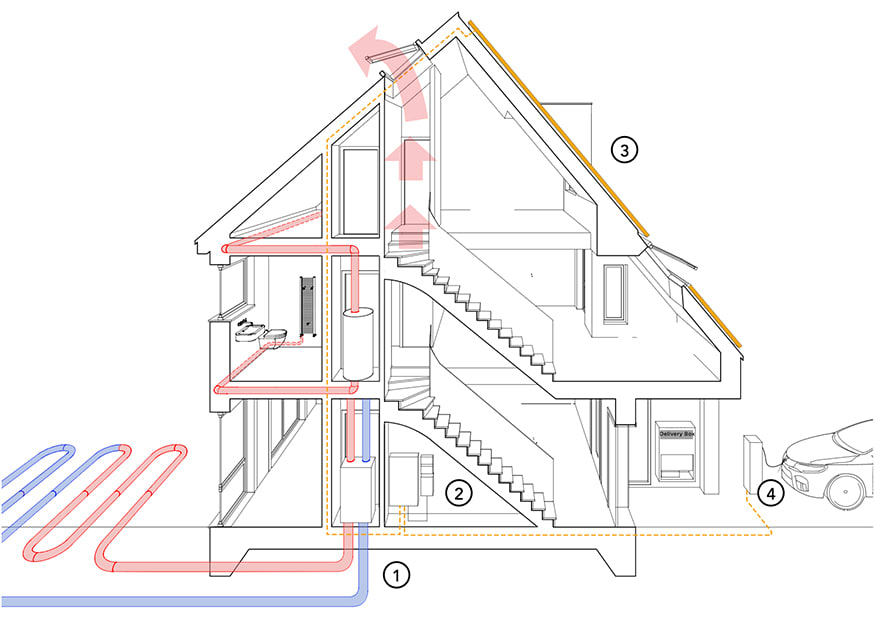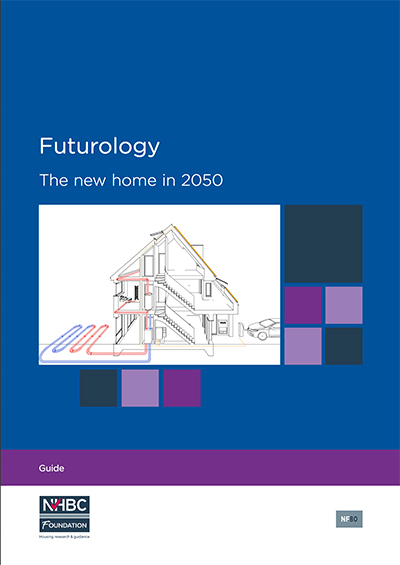The home of the future will generate and store enough surplus energy to charge an electric car, be run via a centralised building management system and incorporate “smart keys” that will give delivery and service firms controlled access.
That’s according to predictions in the latest Futurology report published by the NHBC Foundation, which examines how advances in technology will impact on home design by 2050.
According to the report, the ongoing impact of climate change will mean that, in 30 years, many homes will plug into district heating systems that lose less heat across the network. Heat storage, in the form of thermal stores, will also play a greater role.
The report predicts that many homes will collect energy from solar and wind, store it in a home battery, and use the power for electricity, heat and charge electric vehicles.
Neil Smith, head of standards, innovation and research at NHBC, told BIM+: “Many dwellings will achieve a zero carbon standard and be more or less energy self-sufficient. Climate change increases the risks of homes overheating due to sudden spikes in temperatures, so they will need to make use of thermal mass and a good through flow of ventilation, for example including a central staircase that allows air to flow up from all rooms through a rooflight.”
As energy prices continue to rise, as is expected between now and 2050, homes will adopt building management systems (BMS), already commonplace in non-domestic buildings, to manage energy use more efficiently.
According to the report, some homes will be designed to power down when the occupants leave and the front door is locked, and lighting and ventilation systems will respond to occupancy or movement.
Future home energy use model

1. Heat pumps (ground and air source) 2. Battery storage 3. Large areas of photovoltaic panels 4. Electric car charging
Dwellings will become smarter and build on the current trends for smart devices such as Nest thermostats and Hive heating controllers. The letter box of the future may be clever enough to register deliveries, smart sensors will enable homes to monitor health and activity, potentially reminding occupants to take medication, or safeguard them from accidents, such as scalding water, and ensure that doors and windows are not left unlocked.
Some routine shopping may happen automatically, with fridges and freezers replenishing food when stocks are low.
Smith commented: “Tech manufacturers will be serving new build and existing stock, and because the latter is a much bigger market than new build, gadgets are likely to evolve more as wireless plug and play than systems that require fixed wiring. This should make it easier for the consumer to remove and replace them.”
Although smart technology is likely to reduce in size, the report predicts that designers will have to find space for larger equipment, such as home batteries and insulated hot water cylinders used for thermal storage. The interaction of heating, heat recovery and ventilation systems will also be more complex, requiring extra servicing.
Looking beyond the influence of technology, the report suggests that demographic shifts, such as a rapid increase in the number of elderly people and larger numbers of young people unable to afford to leave home, will drive demand for more multi-generational accommodation.
A lack of affordable homes in urban centres and a growing trend for people living alone will increase demand for micro-living apartments that potentially borrow from the ingenuity of caravan and boat designs to overcome storage and space issues.
In addition, homes are expected to become more flexible and adaptable and, similar to many offices today, allow for the simple reconfiguration of rooms or shared spaces by using lightweight movable walls organised around fixed service “cores”.
The full version of the report can be downloaded here.

Tech manufacturers will be serving new build and existing stock, and because the latter is a much bigger market than new build, gadgets are likely to evolve more as wireless plug and play than systems that require fixed wiring.– Neil Smith, NHBC











